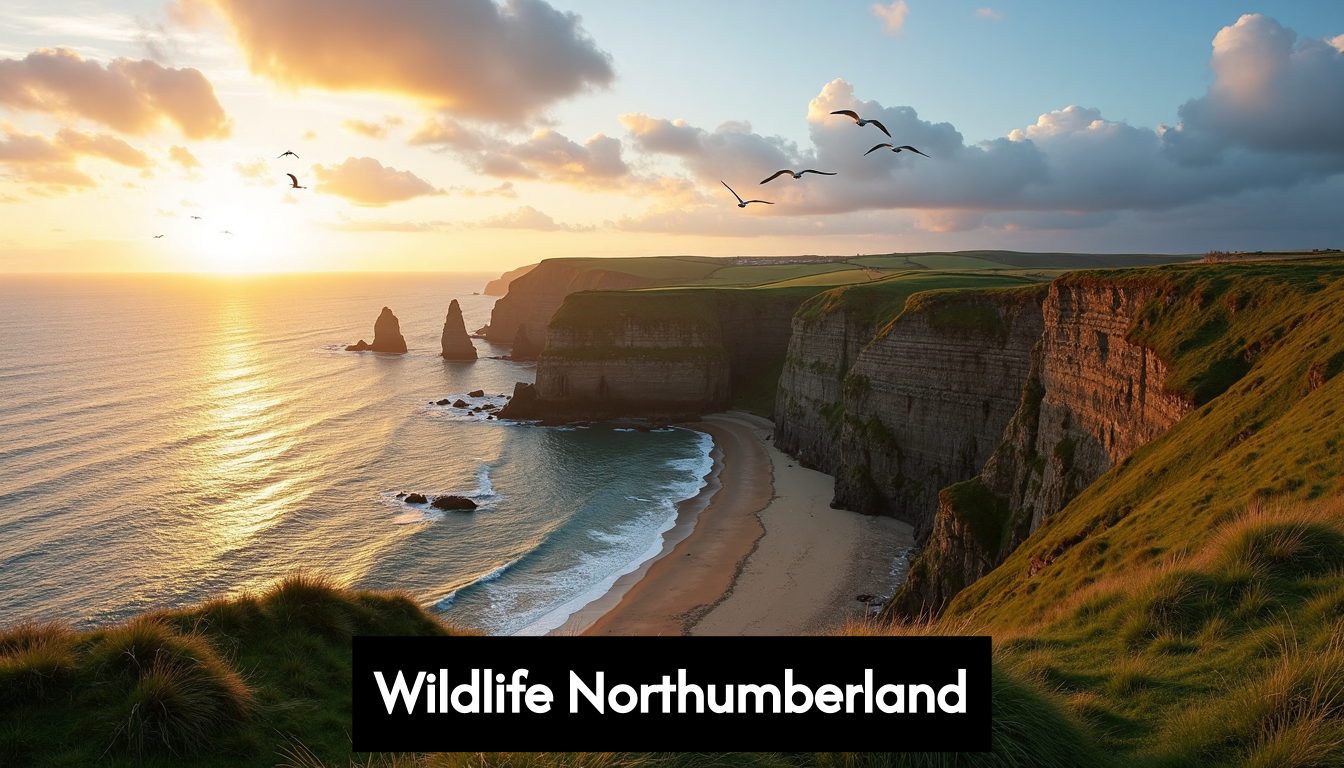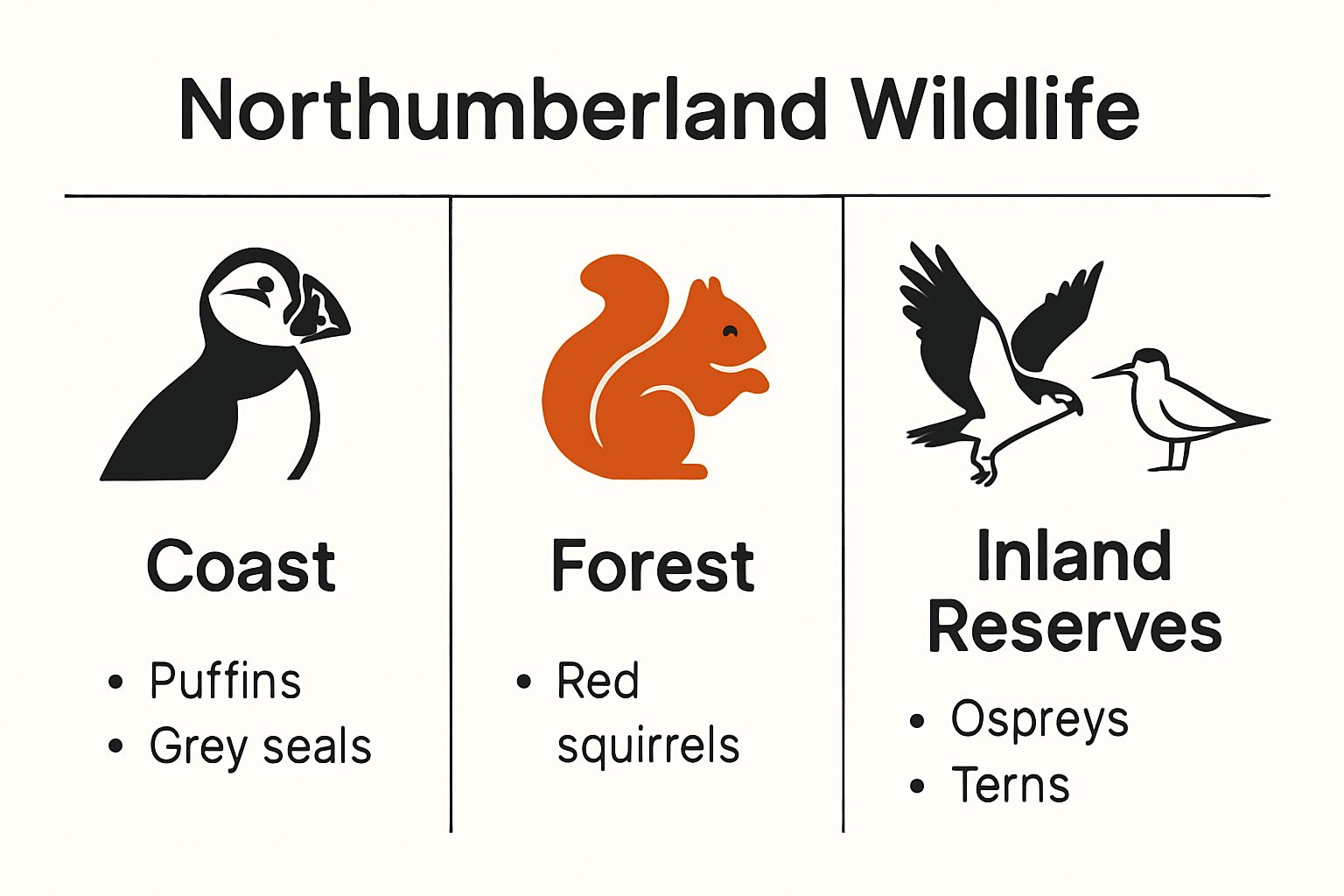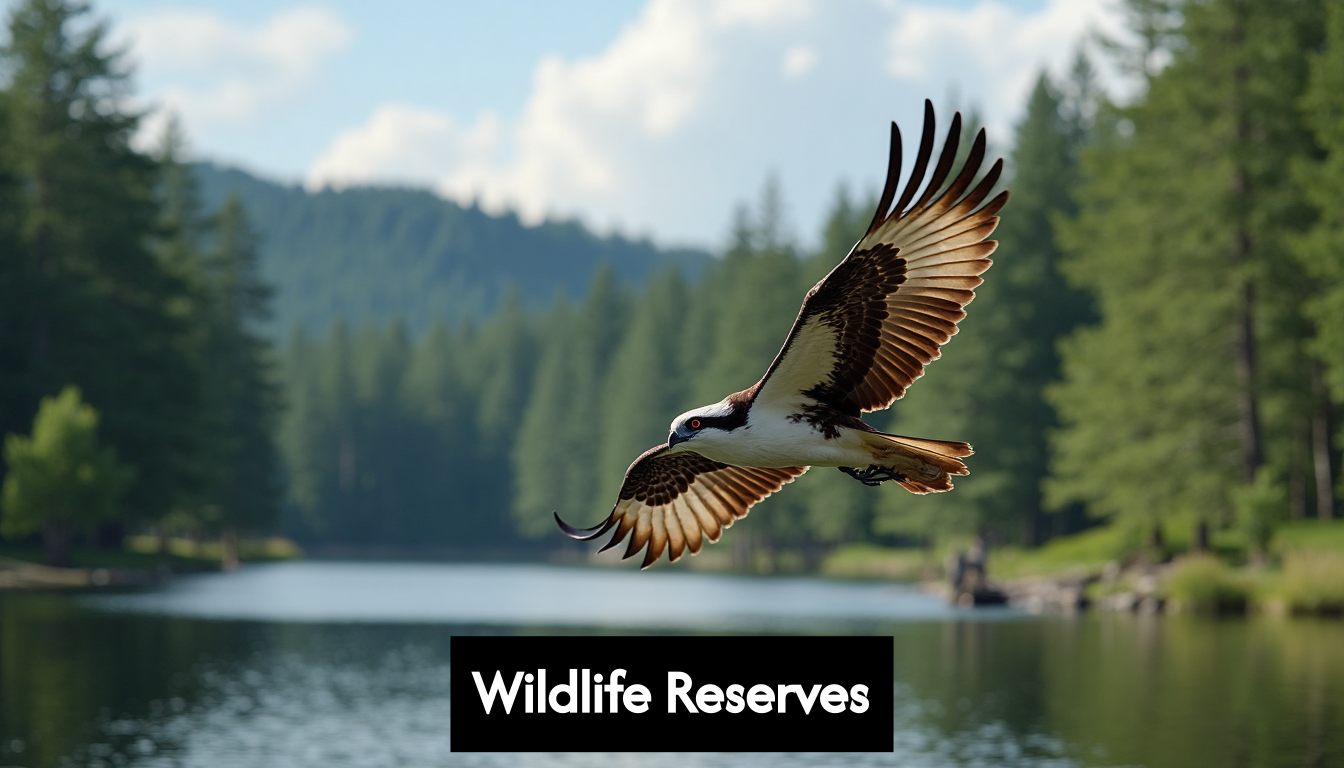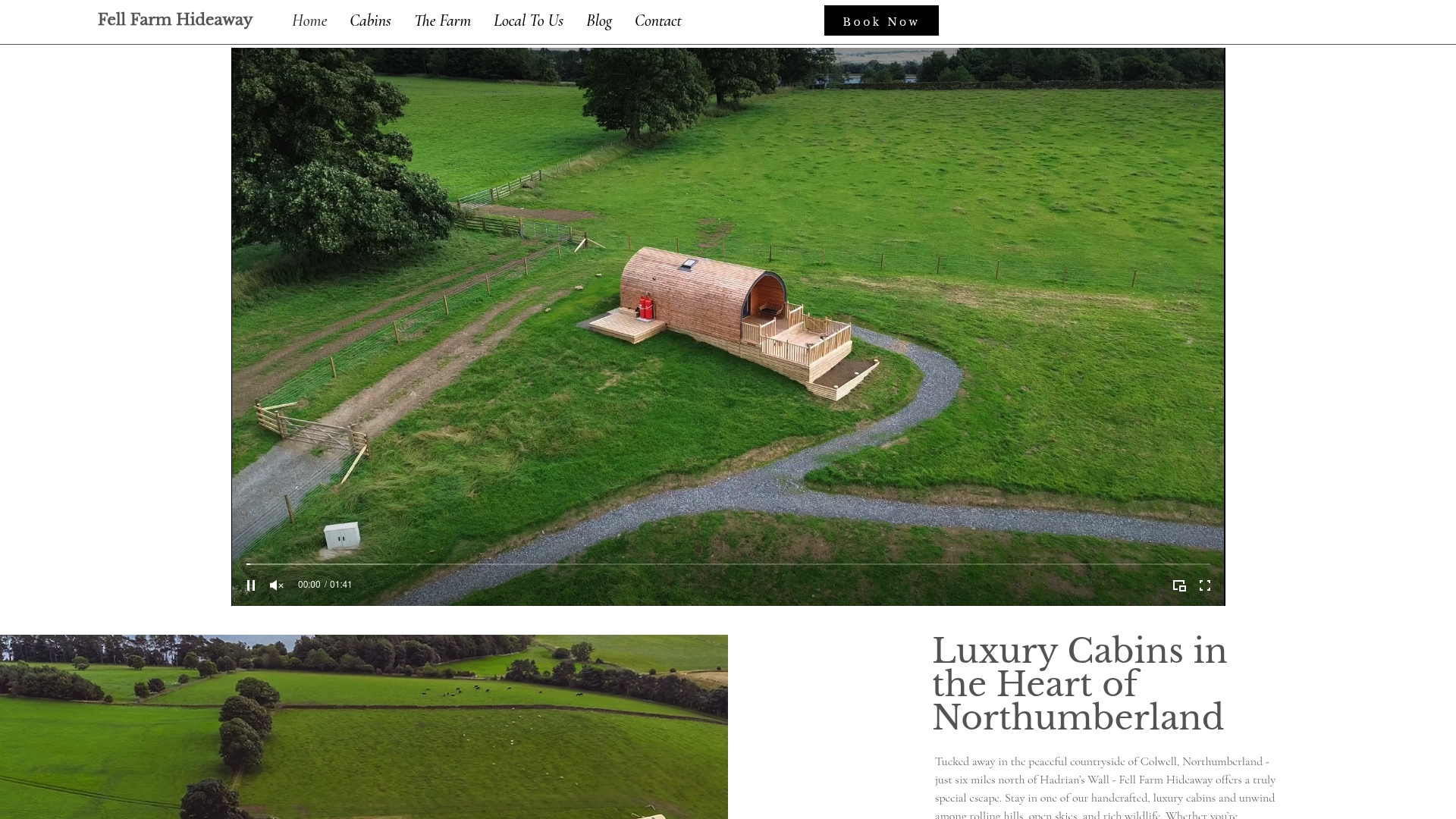Discover Local Wildlife Northumberland: Top Spots for Nature Lovers 2025
- Brendon Hayward
- Jun 16
- 9 min read
Wildlife watching in Northumberland is at a whole new level. You can spot everything from roughly 90,000 puffins on the Farne Islands each summer to rare red squirrels deep in ancient forests. Many expect only the coastline to deliver, thanks to its famous seabird colonies. Strangely enough, though, it is the inland nature reserves and award-winning conservation programmes that steal the show, delivering some of the most intimate and unexpected encounters with the UK’s endangered species. Northumberland’s wild spaces are full of surprises, and each visit promises something rare tucked between the dunes and trees.
Table of Contents
Quick Summary
Best Places to See Wildlife in Northumberland
Northumberland offers an extraordinary landscape for wildlife enthusiasts, presenting diverse ecosystems that support an impressive array of local wildlife. From coastal havens to forest reserves, this northeastern region provides remarkable opportunities to observe native and migratory species in their natural habitats.
Coastal Wildlife Wonders
The Northumberland coastline represents a spectacular wildlife destination, particularly the Farne Islands. These remote islands host an extraordinary marine ecosystem. Research from Natural England reveals these islands support over 20 seabird species, including approximately 90,000 puffins, guillemots, and razorbills. The islands also feature a significant grey seal colony, offering visitors unprecedented wildlife viewing experiences.
Coquet Island presents another remarkable coastal wildlife site. This small rocky island serves as a critical breeding ground for rare roseate terns. Birdwatchers can observe these elegant seabirds during their breeding season, capturing remarkable photographs of these distinctive marine birds. Occasional sightings of bottlenose dolphins and harbour porpoises further enhance the coastal wildlife experience.
Forest and Inland Wildlife Reserves
Kielder Water & Forest Park represents a premier destination for wildlife enthusiasts. This expansive protected area provides critical habitat for numerous species. Wildlife experts from Northumberland Wildlife Trust highlight the park’s significance for osprey populations, offering visitors exceptional opportunities to observe these magnificent birds of prey during their breeding and hunting activities.
East Chevington Nature Reserve offers another extraordinary wildlife viewing location. This remarkable site supports large populations of water birds and represents a critical habitat for breeding marsh harriers - a species not commonly seen in the region. Birdwatchers can potentially spot barn owls, bitterns, and the rare bearded tits, making it a must-visit location for local wildlife enthusiasts.

Conservation and Wildlife Protection
Northumberland’s commitment to wildlife preservation ensures these remarkable ecosystems remain protected. Local conservation efforts focus on maintaining biodiversity and creating sustainable environments for native species. Visitors are encouraged to observe wildlife responsibly, maintaining safe distances and minimizing environmental disruption.
For those seeking an immersive wildlife experience, our Northumberland National Park guide provides additional insights into the region’s remarkable natural landscapes. Whether you are a passionate birdwatcher, marine life enthusiast, or simply appreciate nature’s diversity, Northumberland offers an unparalleled wildlife exploration experience.
Remember to bring binoculars, patience, and a respectful approach when exploring these extraordinary wildlife locations. Each visit contributes to understanding and appreciating the delicate ecosystems that make Northumberland a true wildlife haven.
Seasonal Wildlife Highlights for Visitors
Northumberland transforms throughout the year, offering unique wildlife experiences in each season. Understanding these seasonal variations allows visitors to plan their wildlife watching adventures with precision and excitement.
Spring: Renewal and New Life
Spring in Northumberland emerges as a spectacular season for wildlife enthusiasts. Research from Northumberland Wildlife Trust indicates that March through May represents a critical period of ecological renewal. During these months, the landscape awakens with vibrant wildflower blooms and emerging wildlife.
The Farne Islands become particularly magical during this time. Ornithological experts note that seabird breeding seasons commence, with puffins, guillemots, and razorbills returning to their nesting grounds. Visitors can witness thousands of seabirds preparing their nests and engaging in intricate courtship rituals. Coastal areas become alive with the sounds and movements of these remarkable marine birds.
Red squirrels become increasingly active during spring, emerging from winter hibernation and beginning their breeding cycle. Northumberland National Park provides exceptional opportunities to observe these charismatic creatures in their natural woodland habitats. Their playful interactions and preparation for new offspring make for captivating wildlife watching experiences.
Summer: Peak Wildlife Encounters
Summer represents the pinnacle of wildlife activity in Northumberland. From June to August, extended daylight hours and warmer temperatures create ideal conditions for observing diverse species. Wildlife researchers confirm that this season offers the most comprehensive wildlife viewing opportunities.
The grey seal colonies along the Northumberland coastline become particularly fascinating during summer months. Visitors can observe these marine mammals basking on rocky shores, with occasional sightings of seal pups. Berwick-upon-Tweed provides exceptional vantage points for these marine wildlife encounters. Bottlenose dolphins and harbour porpoises also make sporadic appearances, adding excitement to coastal wildlife watching.
Kielder Water & Forest Park becomes a hotspot for osprey watching during summer. These magnificent birds of prey are most active during breeding season, offering photographers and wildlife enthusiasts remarkable opportunities to observe their hunting and nesting behaviors.
Autumn and Winter: Subtle Wildlife Wonders

Autumn and winter offer a different perspective on Northumberland’s wildlife. As our visitor guide suggests, these seasons reveal the resilience of local wildlife. Migratory birds arrive, transforming the landscape with their unique behaviors.
Barn owls become more visible during these cooler months, hunting across open landscapes. Their silent flight and hunting techniques provide mesmerizing wildlife watching experiences. Deer populations become more concentrated, offering excellent opportunities to observe these majestic animals against the stark winter landscape.
For wildlife enthusiasts, each season in Northumberland presents unique opportunities. Careful planning, patience, and respect for natural habitats ensure memorable encounters with the region’s extraordinary wildlife. Bring warm clothing, binoculars, and a sense of wonder to fully appreciate the seasonal transformations of this remarkable ecosystem.
Family-Friendly Wildlife Experiences and Guided Walks
Northumberland offers an exceptional landscape for families seeking memorable wildlife encounters. From interactive nature centres to guided wildlife walks, the region provides numerous opportunities for children and adults to connect with nature, learn about local ecosystems, and create lasting memories.
Wildlife Discovery Centres and Educational Experiences
Hauxley Wildlife Discovery Centre stands out as a premier destination for family wildlife exploration. Research from Northumberland Wildlife Trust reveals the centre’s comprehensive approach to engaging young naturalists. With dedicated nature discovery trails, strategically placed bird hides, and a natural play area, children can explore and learn about local wildlife in an interactive environment.
The centre offers pond dipping activities, allowing families to discover the microscopic world of aquatic ecosystems. Children can observe and identify tiny creatures, understanding the intricate relationships within water habitats. These hands-on experiences transform wildlife watching from a passive observation to an active learning adventure.
Northumberland Zoo provides another exceptional family-friendly wildlife experience. Housing over 80 species, the zoo offers educational keeper talks and animal displays that captivate visitors of all ages. Zoological experts design these presentations to be both entertaining and informative, helping children develop a deeper understanding of animal conservation and biodiversity.
Guided Wildlife Walks and Expert-Led Experiences
Northumberland Wildlife Trust organizes numerous guided walks and family events that transform wildlife watching into an educational journey. Their “Big Wild Weekend” and “Osprey Watch” events provide structured opportunities for families to explore local wildlife with expert guidance. Wildlife researchers emphasize the importance of these guided experiences in fostering environmental awareness and conservation appreciation.
Kielder Water & Forest Park offers family-friendly walking routes that combine scenic beauty with wildlife exploration. Our walking routes guide highlights trails suitable for different age groups and fitness levels. Parents can enjoy leisurely walks while children learn to identify local bird species, spot red squirrels, and understand forest ecosystems.
Preparing for Family Wildlife Adventures
Successful family wildlife experiences require careful preparation. Experts recommend bringing essential items such as binoculars, field guides, comfortable walking shoes, and weather-appropriate clothing. Encouraging children to keep wildlife journals can transform the experience into an engaging educational activity, helping them document their observations and develop scientific curiosity.

It is crucial to teach children about responsible wildlife watching. This includes maintaining safe distances from animals, avoiding loud noises, and respecting natural habitats. Many local wildlife centres provide educational resources and guidelines to help families minimize their environmental impact while enjoying close encounters with nature.
Northumberland’s diverse wildlife experiences offer something for every family. Whether exploring interactive discovery centres, joining guided walks, or observing animals in their natural habitats, families can create meaningful connections with the natural world. These experiences not only provide entertainment but also cultivate a lifelong appreciation for wildlife conservation and environmental stewardship.
Conservation, Eco-Tourism, and Responsible Viewing
Northumberland stands at the forefront of wildlife conservation, offering visitors a model for responsible ecological engagement and sustainable tourism. The region’s commitment to preserving its unique biodiversity goes beyond mere observation, creating a holistic approach to environmental stewardship and wildlife protection.
Protecting Vulnerable Species
Research from Natural England reveals a critical landscape of conservation efforts in Northumberland. Nearly 1 in 6 species in the UK face potential extinction, making local conservation strategies paramount. The region prioritizes protecting several vulnerable species, including red squirrels, otters, bats, great crested newts, and water voles.
These protected species represent more than individual animal populations. They are integral indicators of ecosystem health. Red squirrels, for instance, serve as key environmental barometers, their population dynamics reflecting broader ecological changes. Conservation efforts focus not just on individual species but on maintaining complex interconnected habitats that support diverse wildlife communities.
Local Nature Recovery Strategies
Northumberland has pioneered innovative approaches to wildlife conservation through Local Nature Recovery Strategies (LNRS). Conservation experts explain these strategies involve comprehensive community engagement and policy development aimed at enhancing ecological integrity. These strategies create collaborative frameworks where local communities, researchers, and policymakers work together to protect and restore natural environments.
The LNRS approach transforms conservation from a top-down mandate into a community-driven movement. By involving local stakeholders, these strategies ensure that conservation efforts are contextually relevant, scientifically informed, and socially supported. This model represents a progressive approach to environmental management that balances human needs with ecological preservation.
Responsible Wildlife Viewing Practices
Eco-tourism in Northumberland emphasizes minimal environmental impact and maximum respect for wildlife. Our nature retreat guide highlights essential principles for responsible wildlife viewing. These include maintaining safe distances from animals, avoiding disruption of natural behaviors, and minimizing noise and visual pollution.
Visitors are encouraged to adopt a “leave no trace” philosophy. This means carrying out all personal waste, staying on designated trails, and using binoculars or telephoto lenses for wildlife observation instead of attempting close approaches. Educational programs at wildlife centres and national parks provide visitors with comprehensive guidelines on ethical wildlife interactions.
Technology also plays a crucial role in modern conservation efforts. Researchers use advanced tracking methods, camera traps, and genetic studies to monitor wildlife populations without invasive interventions. These technologies provide valuable data while minimizing direct human interference in natural habitats.
Conservation in Northumberland represents more than protecting individual species. It is about maintaining complex ecological networks, supporting biodiversity, and creating sustainable relationships between humans and the natural world. By choosing responsible tourism practices, visitors become active participants in these critical conservation efforts, helping to preserve Northumberland’s rich and diverse wildlife for future generations.

Remember, every wildlife encounter is an opportunity to learn, appreciate, and contribute to conservation. Approach nature with respect, curiosity, and a commitment to preservation.
Frequently Asked Questions
What are the best places to see wildlife in Northumberland?
Northumberland offers diverse wildlife viewing locations, including the Farne Islands for seabirds like puffins and guillemots, and Kielder Water & Forest Park, where you can spot ospreys and other species in their natural habitats.
When is the best time to visit Northumberland for wildlife watching?
The best time for wildlife watching in Northumberland varies by season. Spring (March to May) is great for seabird nesting, summer (June to August) peaks with activity, including seal pups, while autumn and winter showcase migratory birds and elevated deer sightings.
Are there family-friendly wildlife experiences in Northumberland?
Yes, Northumberland has many family-friendly activities such as Hauxley Wildlife Discovery Centre, which offers nature trails and pond dipping, and Northumberland Zoo, providing educational talks and displays about animals and conservation.
How can I practice responsible wildlife viewing in Northumberland?
Practising responsible wildlife viewing includes maintaining safe distances from animals, adhering to ‘leave no trace’ principles, and using binoculars for observation rather than approaching closely, all of which contribute to minimising disruption to wildlife.
Experience Northumberland’s Wildlife Up Close at Fell Farm Hideaway
Longing for a truly wild adventure that goes beyond simply watching from afar? The article highlighted how spotting rare red squirrels, ospreys, and barn owls often means searching for the quietest corners of Northumberland. Yet, finding that peaceful base where you can actually wake to birdsong and spot wildlife right outside your window is not always easy. The real challenge for many nature enthusiasts is escaping crowded hotspots whilst staying close to the magic, and connecting deeply with nature at your own pace.
At Fell Farm Hideaway, you are invited to experience wildlife in a way that is personal and meaningful. Our self-catering cabins blend rustic charm with modern comfort, nestled among rolling hills and ancient woodland. Enjoy trails starting from your cabin door and share in our commitment to biodiversity and sustainability. Whether you plan to venture out to the top wildlife spots in Northumberland or simply relax and let the countryside reveal its wonders, your adventure starts the moment you arrive. Book your stay today and let the sights and sounds of nature become the highlight of your visit. Your next wildlife encounter could be just outside your cabin.
Comments